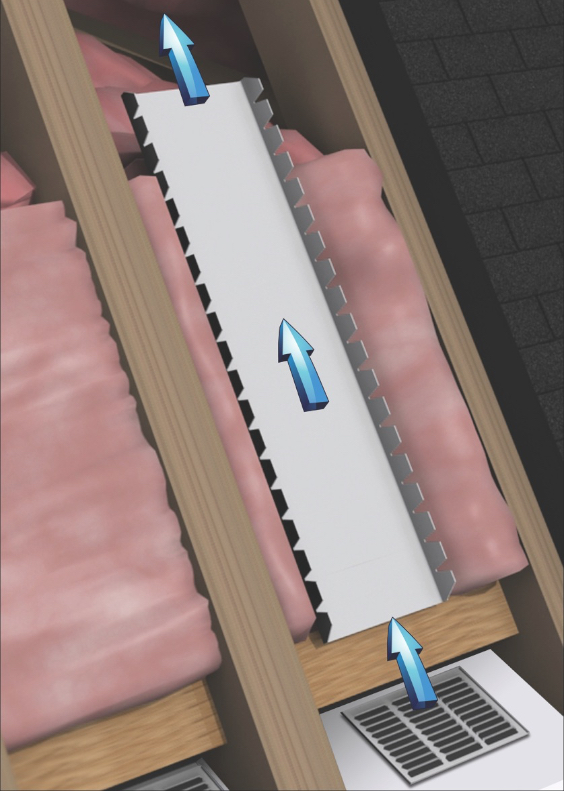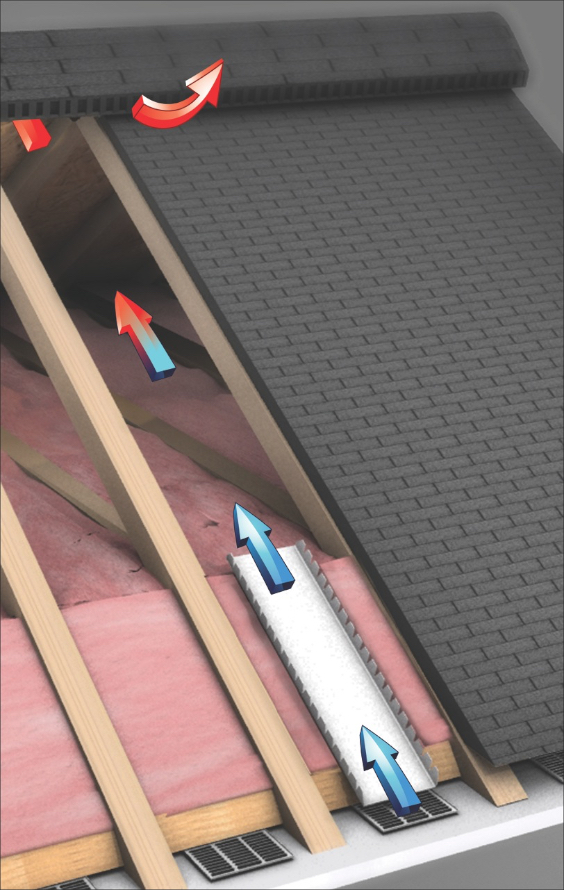VBaffle
Retrofit Attic Ventilation Baffle
As a homeowner, there are many things that you can do to reduce your heating and cooling bills, but very few play such an intricate part as soffit vent baffles. In the last 50 years, millions of houses have been built with cathedral, vaulted, and angled ceilings. In most cases the soffit baffles that were installed were only put where a soffit vent was located. There are several problems with this and we will try to cover all of them so that you'll have a good understanding of exactly how the ventilation in your house works; and just how important vaulted ceiling ventilation baffles are..
We first need to make sure that your house meets code. Standard building code requires one square foot of intake ventilation for every 300 square feet of attic space. So a 2000 square foot house with a standard 400 square foot garage will need 8 square feet of intake. There are 144 inches in a square foot, and a standard 8 inch by 16 inch soffit vent has 56 inches of net free air flow. The attic ventilation baffles that are installed during new construction typically have between 8-12 inches of net free air flow. So, if only one soffit baffle per soffit vent is installed, you are reducing 56 inches of net free airflow down to 8-12 inches of net free airflow. This is an 80% reduction in net free airflow! The most obvious result of this is a hot humid attic.
This humidity gets trapped in your attic then settles inside your insulation and immediately reduces its effectiveness. Over time, as this moisture continues to develop in your attic, the extra weight of the moisture causes your insulation to settle. If you have any leaks in your HVA/C system, this affect is multiplied. This is also a breeding ground for mold and midew, which can develop on your sheetrock, junction boxes, A/C registers, and in or around your HVA/C system.
If you have powered vents, solar or electric, the lack of intake will create a vacuum in the attic. This vacuum will cause the powered vents to pull air from the light fixtures, ceiling fans, knee walls, and any other opening in the house into your attic, which in turn creates a vacuum in your house; so hot dusty air from outside is pulled into your house from any leaks in windows and doors. This vacuum in the attic also creates a back pressure on the powered fans, overheating the motors causing them to burn out faster.
Limited intake creates hot attics and negative pressures, which lead to high utility bills and a dusty house.

“Soffit Vent Baffles Are The Key To Having Enough Intake Ventilation From Eave Vents.”
Not only does the lack of attic intake ventilation affect the whole house, it also directly affects the rooms where the intake is lacking. Cathedral, vaulted and angled ceilings follow the roof line, in other words the rafter is doubled as a ceiling joist, until they flatten out. So if someone has 10 foot ceilings but only 8 foot outside walls, then the ceiling will follow the angle of the roof line until it gets to the desired height. It's almost like a sandwich; sheetrock on the bottom, insulation in the middle and roof decking on the top. The bottom of these angled ceiling sections go into the soffit area, the top leads into the attic, just like the picture to the left shows.
As the sun heats up the roof, the heat is conducted through the roof deck into the insulation. If the rafter cavities do not have soffit baffles, then the heat and moisture that develops inside the rafter cavity has nowhere to vent. This heat is then transferred through the sheetrock and into the house. This of course causes the room to be warmer than the rest of the house. If these rooms are being used on a daily basis, the most common temporary solution to this is to turn down the thermostat; this of course raises the electric bill.
In the Summer, we're worried about the heat coming in, but in the Winter, we're concerned about the heat getting out. As the moisture builds up in the unbaffled rafter cavities the R-Value of the insulation is deminished. This in turn allows the heat to escape faster in the rooms with angled ceilings. So, you either turn the thermostat up or buy a space heater for the room; both of which raises the electric and or gas bills.
Roof rot is also caused by rafter cavities without attic ventilation baffles. Because there is very, very limited air movement in an unbaffled rafter cavity, moisture will develop; especially in humid areas. This moisture will absorb into the roof decking causing it to rot. It will also cause the roofing nails inside the rafter cavity to rust. This of course takes years to occur but it is easily prevented with soffit vent baffles..
By allowing fresh air into your attic you will:
•Dramatically lower your attics temperature
•Prevent moisture buildup in your insulation
•Prevent mold and mildew in your attic
•Prevent roof rot
•Reduce your energy bills all year long
•Eliminate hot and cold rooms
•And so much more...

This Thermal Video Shows The Effectiveness of Soffit Vent Baffles in Attic Ventilation.
This thermal video was taken just before 4:30 p.m., on the 24th of September. This is the same master bedroom that the other thermal images came from, the only difference being, the time of day that it was taken. This is very important to note, given the fact that the bedroom is located on the East side of the house. Even though the sun was no longer directly hitting that side of the roof, the heat that built up in the rafter cavity that didn't have a soffit baffle was still coming into the house. When every rafter cavity in cathedral ceilings have attic ventilation baffles, the insulation can dissipate the heat faster, because fresh air from the soffit vent is flowing over the insulation like a cool Summer breeze.